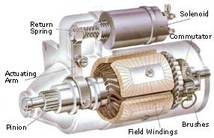Solenoid
A solenoid is a loop of wire, often wrapped around a metallic core, which produces a magnetic field when an electrical current is passed through it. Solenoids are important because they can create controlled magnetic fields and can be used as electromagnets.
In engineering, the term solenoid may also refer to some transducer devices that convert energy into linear momentum. Three common types of solenoids are electromechanical solenoids, which harness electrical energy; pneumatic solenoids, which derive their energy from compressed air and hydraulic solenoids, which obtain energy from pressurized fluids.
Electromechanical solenoids
Electromechanical solenoids consist of an electromagnetically inductive coil wound around a movable steel or iron slug. The coil is shaped such that the slug can be moved in and out of the center, altering the coil's inductance and thereby becoming an electromagnet. The force applied to the slug is proportional to the change in inductance of the coil with respect to the change in position of the slug, and the current flowing through the coil. The force applied to the slug will always move the slug in a direction that increases the coil's inductance.
Pneumatic solenoids
A pneumatic solenoid is designed much like the piston in an automobile engine. The housing consists of a hollow tube, usually metal, that is capped on either end. Both ends have one or more ports for intake and exhaust. The actuator itself is connected to the piston by a rod that passes through the centre of one end. To stroke the solenoid pressure is applied to one end of the device, while the other end is allowed to vent. To reverse the movement pressure is applied to the opposite side of the piston. Industrial solenoids are capable of applying enormous pressure using relatively low pressure supplies. The larger the diameter of the housing, the greater the force applied to the actuator for a given supply pressure.
Hydraulic solenoids
Hydraulic solenoids are in general similar to pneumatic solenoids except that they are more durable, with tighter tolerances and exert much higher forces. Hydraulic brakes use solenoids to bend sheets of titanium in aerospace manufacturing, for example.
